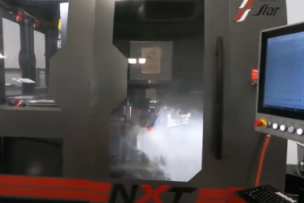Visual checks: David McHenry, engineering and technical manager for Rego-Fix USA, agrees, adding that routine visual inspection of toolholders and components is equally important. “Let’s be honest, shops are often too busy to sit and look over every single toolholder between cutting tool changes. From a longevity and performance perspective, though, we wish they would. Doing so helps them identify the witness marks that indicate a chip has wedged itself in the spindle taper, or that someone has mishandled the toolholder at some point. Catching those things early prevents further damage to the toolholder or the machine spindle.”
Ditch the breaker bar: Speaking of mishandling toolholders, it starts with improper torquing. McHenry’s colleague at Rego-Fix is Jeff Schemel, North American sales manager. He notes that ER collets in particular are susceptible to overtightening, and that the amount of torque to apply depends on the size of the collet and its manufacturer. “Small collets are very easy to overtighten, as are those with a lubricious coating,” he says. “That’s why we always recommend following the manufacturer’s torque chart and assembly instructions for all tooling, ER collets or otherwise.”
Retention reasons: This holds true for retention knobs as well. According to Ronald West, senior global product manager for tooling systems at Kennametal, too much torque can bell-mouth the metal around the retention knob, leading to damage of the spindle and toolholder alike. Too little and it might come loose during operation, with catastrophic results. Says West, “I was guilty of these and other bad practices during my days in the shop, but since coming to work for a tooling manufacturer, I’ve come to appreciate how sophisticated these products really are. Always buy high-quality retention knobs, and always use a torque wrench to tighten them to the specified manufacturer’s torque requirement.”
Read more: Additive Manufacturing: 5 Things You Need to Know About 3D Printing
Carts are for horses: And stop throwing toolholders in drawers, he adds, where they’re free to roll around and create all manner of nicks and dings on precision-ground surfaces. West and others strongly recommend transporting tools in a dedicated CNC tool cart and storing tools in their original containers or a rack that will keep them separated. He also suggests using a plastic sleeve to cover assembled tools before wheeling them out to the shop floor, lest a passerby brush an arm against a sharp cutting tool.








Talk to Us!
Leave a reply
Your email address will not be published. Required fields are marked *